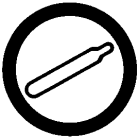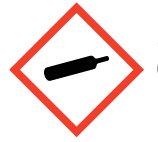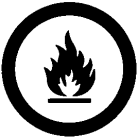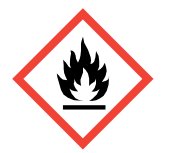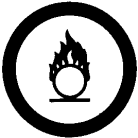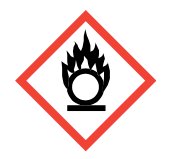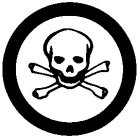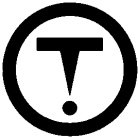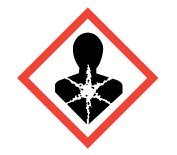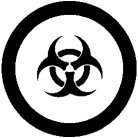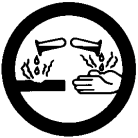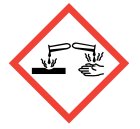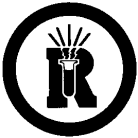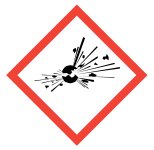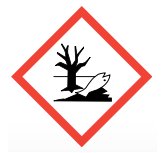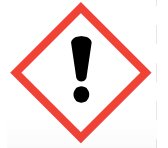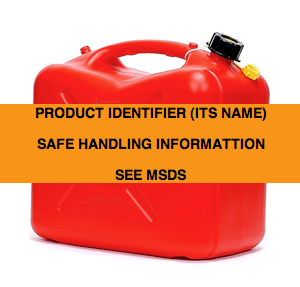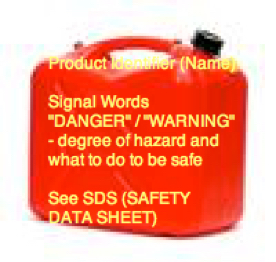DO NOT COPY - ALL contents - Copyright Protected
DRAM Ventures Inc. / www.firesafetraining.com
Table of Contents
1. 2015 WHMIS / GHS Overview
2. 2015 WHMIS Classification
3. 2015 WHMIS Labels
4. 2015 WHMIS / GHS SDS (Safety Data Sheet)
5. 2015 WHMIS / GHS Summary & Quiz
WHMIS 2015 / GST Classification
(Hazard Groups, Categories Symbols & Pictograms)
In order for a controlled material or substance to be given a Classification, a Pictogram and ultimately - in the workplace, a Label
The manufacturer / supplier, must consider what;
(Hazard) Group
- Physical
- Health
- Environmental* (in GHS but not adopted by Health Canada in WHMIS 2015)
- Explosive* (in GHS but not being adopted (is covered by Explosive Regulation Act) however you may still see the Exploding Bomb pictogram on WHMIS 2015 Labels
(Hazard) Classification
- will have at least one Hazard Category
(Hazard) Category (categorize)
(may also be broken down into further sub-categories)
Degree of Severity of Danger of the product.
Category 1 to Category 4
- Category 1 being the MOST DANGEROUS
- Category 4 being the least dangerous
Once the above is determined, a / S.D.S. (2015) can be developed.
From that - the Supplier Label will be created
Signal Words
(Communicating, yet again, more immediate information)
Two Signal Words are used in GHS and have been adopted by WHMIS 2015.
- "DANGER" - HIGH RISK
- "WARNING"- LESS SEVERE HAZARDS
These will be followed by a HAZARD STATEMENT of a few words describing the more critical RISK(S) involved.
This will be displayed on the Supplier Label - see next section
Note: The table below does not have to be memorized. It is for your reference to help better understand how the classification system is Grouped.
LEARN ABOUT ALL HAZARDOUS MATERIAL THAT MAY BE IN YOUR WORKPLACE / SITE (SEE THE SDS)
Physical Hazards Group
Health Hazards Group
Environmental Group+
Explosives*
Flammable gasses
Flammable aerosols
Oxidizing gases
Gases under pressure
Flammable liquids
Flammable solids
Self-reactive substances and mixtures
Pyrophoric liquids
Pyrophoric solids
Self-heating substances and mixtures
Substances and mixtures which, in contact with water, emit flammable gases
Oxidizing liquids
Oxidizing solids
Organic peroxides
Corrosive to metals
Combustible dusts
Simple asphyxiants
Pyrophoric gases
Physical hazards not others classified
Acute toxicity
Skin corrosion / irritation
Serious eye damage / eye irritation
Respiratory or skin sessitization
Germ cell mutagenicity
Carcinogenicity
Reproductive toxicity
Specific target organ toxicity - single exposure
Specific target organ toxicity - repeated exposure
Aspiration hazard
Bio-hazardous infections materials
Health hazards not otherwise classified
Hazardous to the aquatic environment
Hazardous to the ozone layer
A point of clarification. See below
|
A symbol (right) has no "frame or border" thus it is not a pictogram. |
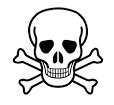 |
|
A pictogram consists of a symbol with the frame or border" around it. A symbol is usually (not always) "inserted into" a border frame. For the purpose of this course, if we say "symbol" or "pictogram" we mean one and the same. |
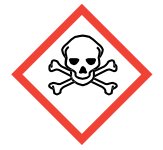 |
DO NOT COPY - ALL contents - Copyright Protected
DRAM Ventures Inc. / www.firesafetraining.com
WHMIS 2015 / GHS uses ten (10) Classifications (Pictograms)
IF A PRODUCT MEETS THE CRITERIA WITHIN THESE CLASSIFICATIONS THEN THAT PRODUCT IS CALLED A CONTROLLED PRODUCT AND IS SUBJECT TO WHMIS REGULATIONS
The HAZARDOUS PRODUCTS ACT and the CONTROLLED PRODUCTS REGULATIONS do not require WHMIS labels and for the following types of products;
- a restricted product when packaged as a consumer product (example - bleach which is within a bottle of bleach for sale in a grocery or other type of store)
- explosives - because they are already regulated by the Explosives Act
- any product or substance such as cosmetic, drug or food which is already "covered" by the Food and Drugs Act
- any pest control product within the meaning of the Pest Control Products Act
- a prescribed substance (an example could be certain medications) within the meaning of the Atomic Energy Control Act
- wood or wood products
- a manufactured product (various composites and particle boards, or a tire which has chemicals in it but once it is in a store it is considered safe for it's intended use )
- tobacco or products made of tobacco
- hazardous wastes
- hazardous goods being transported also do not "fall" under WHMIS because these good are already regulated by the DANGEROUS GOODS ACT
|
1988 WHMIS Classification Symbols |
WHMIS 2015 / GHS Classification Symbols |
- Compressed gases - Dissolved gases - Liquified gases by compression or refrigeration |
- Gases under pressure |
Any substance which may catch fire or explode with an ignition source FLAMMABLE - the substance will ignite more easily than COMBUSTIBLE Example: Acetone is more FLAMMABLE than a COMBUSTIBLE liquid such as Kerosene. |
Flammable Hazards |
The product contributes to the combustion of another material by yielding oxygen or other oxidizing substance or it is an organic peroxide |
Oxidizing Hazards |
DIVISION 1 - Materials causing immediate and serious toxic effects. (can cause death in small amounts) (examples are sodium cyanide and hydrogen sulphide) |
Very toxic material that can cause illness or death with small amounts and short time exposure |
This symbol / pictogram is not used in WHMIS 2015 / GHS Can cause immediate or long-term effects. Some long-term affects may lead to death (example - asbestos exposure may lead to cancer thus death) |
Materials that can cause serious health effects |
|
The continued use of the above (Biohazardous) symbol/pictogram is still under review |
|
Corrosive damage to materials as well as skin, eyes, body in general |
|
The above two pictograms replace the 1988 pictogram at left. |
ABOVE: The 1988 WHMIS symbol / pictogram on left is no longer used. Note the two pictograms on the right.
|
|
For explosive, unstable hazards |
|
NOTE: The GHS system also defined an Environmental hazards group. This group (and its classes) was not adopted into WHMIS 2015. ... but, you may still see the environmental classes listed on labels and SDSs. Including information about environmental hazards is allowed by WHMIS 2015. |
for materials that can cause damage to the aquatic environment or the ozone layer. |
|
|
|
for materials that can cause health effects less serious than those using the health hazard pictogram
REGARDING ALL OF THE ABOVE PICTOGRAMS
- YOU MAY NOT REMEMBER THEIR NAME OR EXACT MEANING
HOWEVER
- IF YOU SEE ANY OF THESE PICTOGRAMS ON ANY WORKPLACE CONTAINER LABEL,
STOP WORKING
UNTIL ... YOU TAKE A CLOSE LOOK AT THE LABEL
AND
READ THE (SDS)
- YOU WILL LEARN EVERYTHING YOU NEED FROM THE (SDS) ABOUT THE SUBSTANCE OR PRODUCT IN ORDER TO BE ABLE TO WORK SAFELY AROUND OR WITH THE SPECIFIC LABELED MATERIAL
|
The Biohazardous Pictogram on the right is under review for continued use in the 2015 WHMIS? (True or False) |
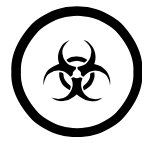 |
SUMMARY OF SOME EXEMPTIONS
Some products do not require the WHMIS HAZARD LABELS and SYMBOLS because they are already regulated by other labeling legislation. (i.e. Pesticides, Explosives, and Radioactive Material are just some examples) Also, when any CONTROLLED PRODUCT is being transported, the legislation then is that of TRANSPORTATION OF DANGEROUS GOODS, even though, when the material (containers) arrive in a warehouse then they must be considered to be under WHMIS LEGISLATION.
Some examples of workplaces and the Hazardous Materials employees may be working with.
1) Fiberglass boat building;
- acetone
- fiberglass resin
- paints
- solvents
- fiberglass dust
2) Wooden Furniture Manufacturing
- the wood itself is not a concern
- dust from sanding
- wood finishing materials
- various glues
3) Forestry Workers / Wildland Firefighters
- gasoline
- diesel
- aviation fuel
- various fire retardents
- various fire acellerators
- propane (camps)
- Bear Spray - this is unique in that it is sold in retail outlets and will probably not have a formal WHMIS label. However, these products should be transported in a special box outside of the area that drivers (or pilot) and passengers occupy. You MUST ALWAYS CONSULT WITH THE HELICOPTER OR FIXED WING PILOT PRIOR TO BRINGING BEAR SPRAY OR OTHER HAZARDOUS MATERIALS ON BOARD! THIS ALSO APPLIES TO MOTOR VEHICLE TRANSPORTATION. (CREW PASSENGER TRUCKS / BUSSES)
Exercise:
Make up a list of the hazardous materials that may be in your workplace - then, match these materials to the appropriate Class and/or Division and the actual Symbol.
|
1988 WHMIS Example: Gasoline -
Class B - Class D - Division 1 Division 2 |
2015 WHMIS Example - Gasoline
Flammable |
You may think of other controlled products that are in your place of employment.
DO NOT COPY - ALL contents - Copyright Protected
DRAM Ventures Inc. / www.firesafetraining.com
DO NOT COPY - ALL contents - Copyright Protected
DRAM Ventures Inc. / www.firesafetraining.com
We wish to acknowledge and thank all organizations and persons for the use of all videos and photos on this web site.
